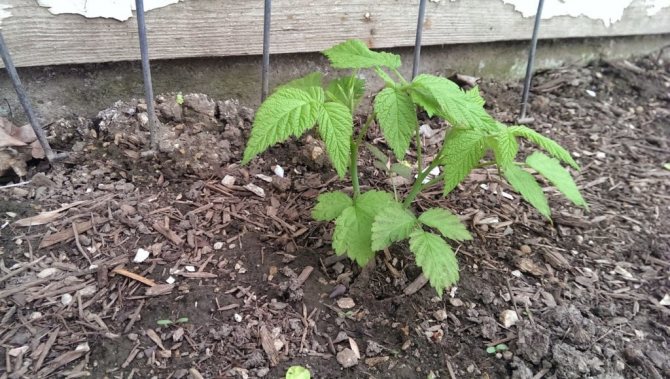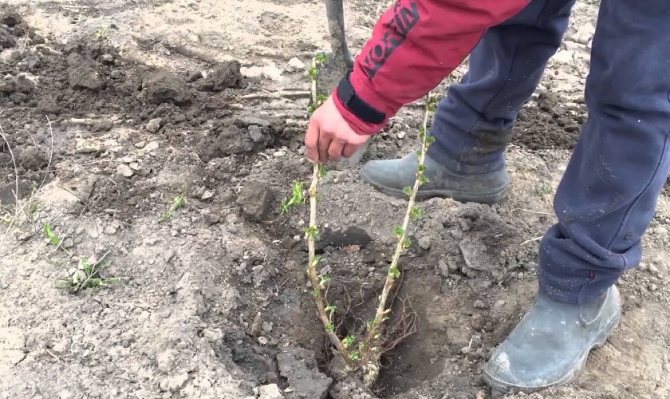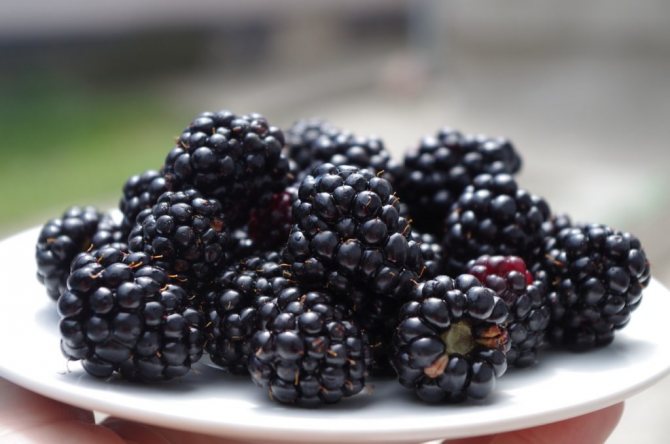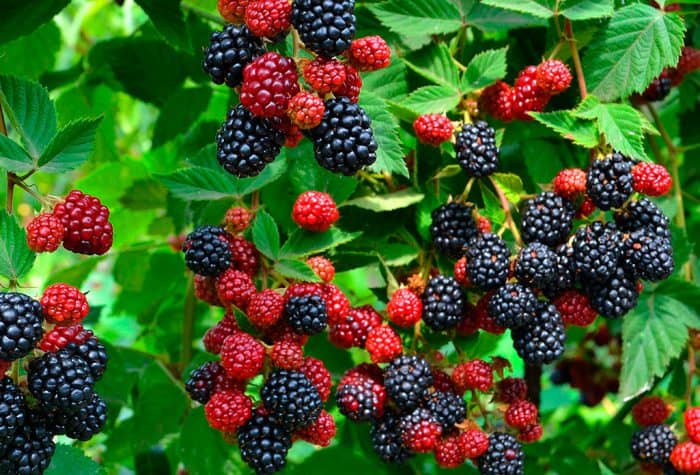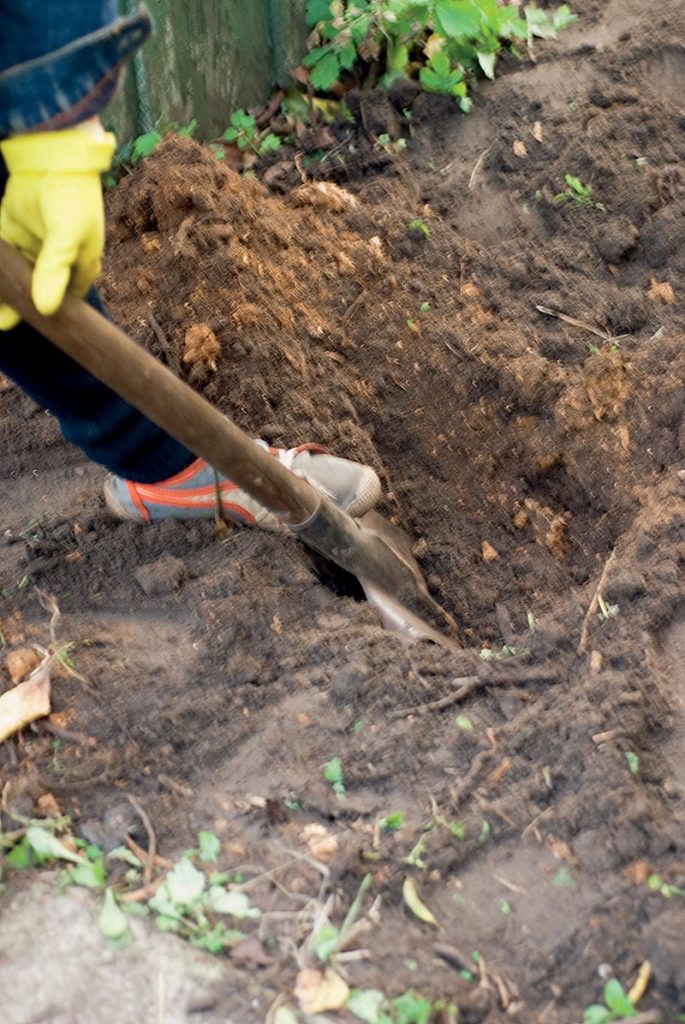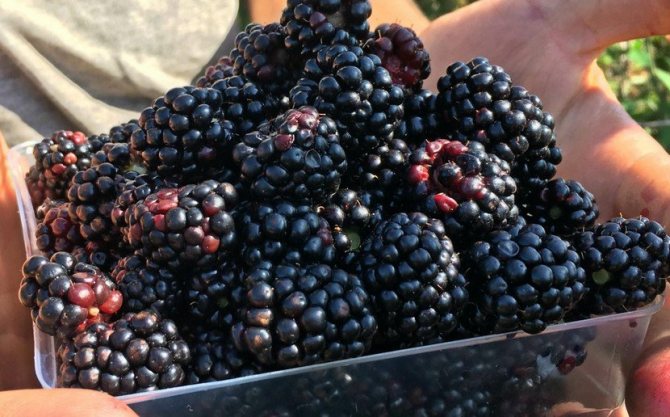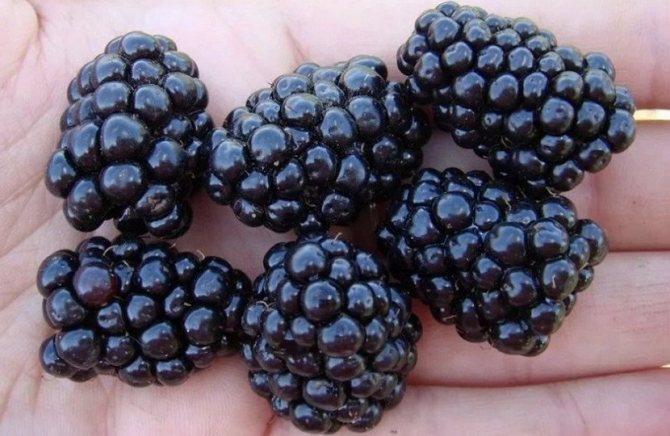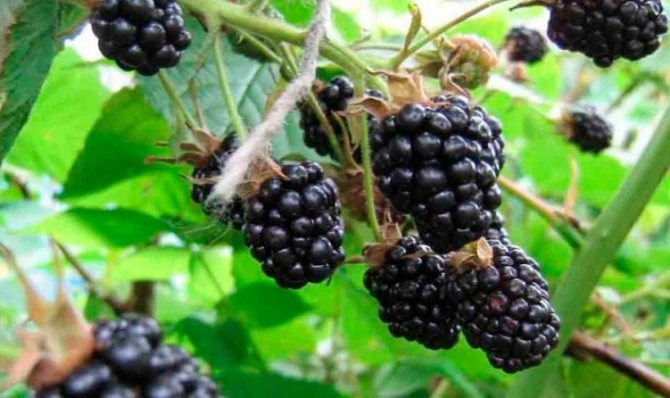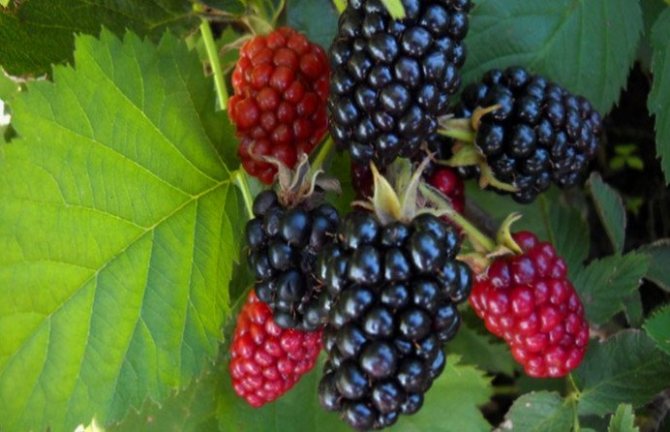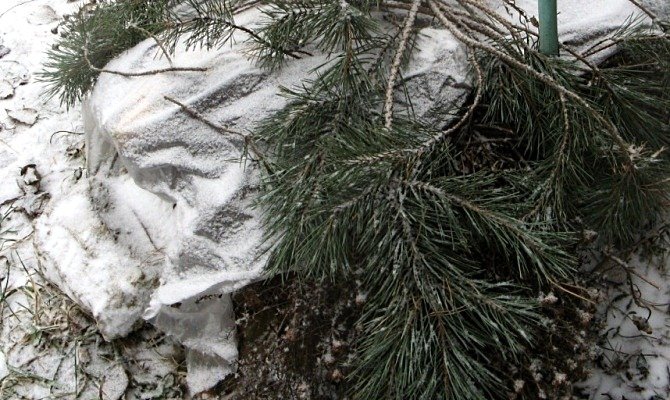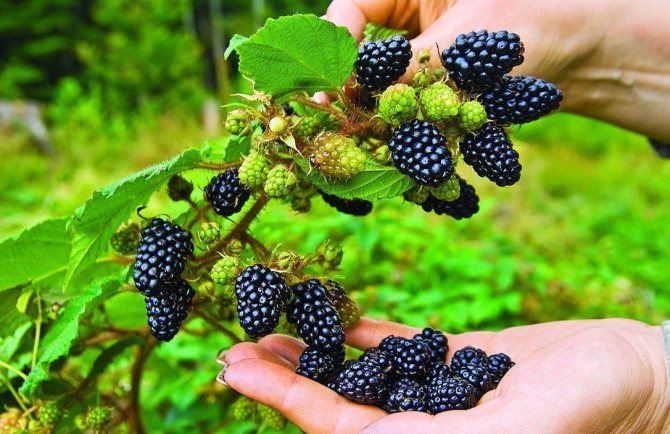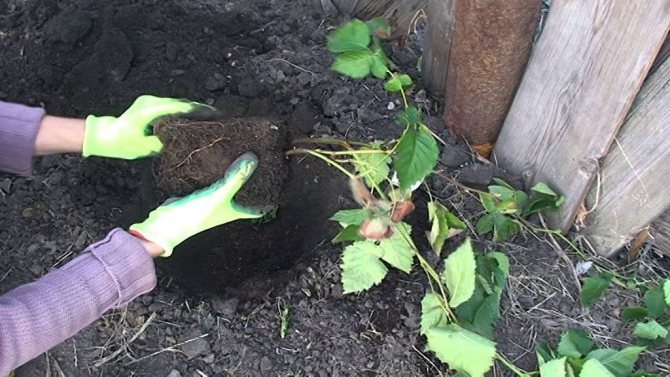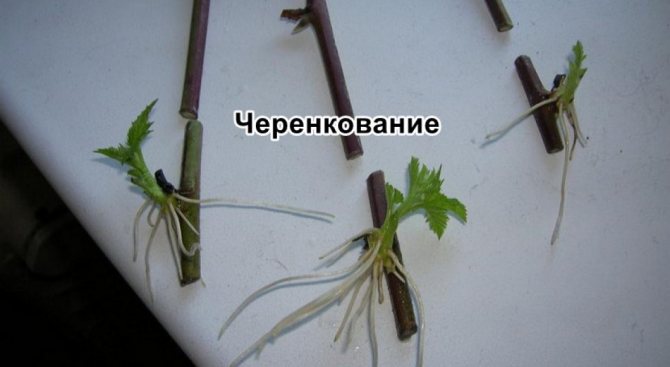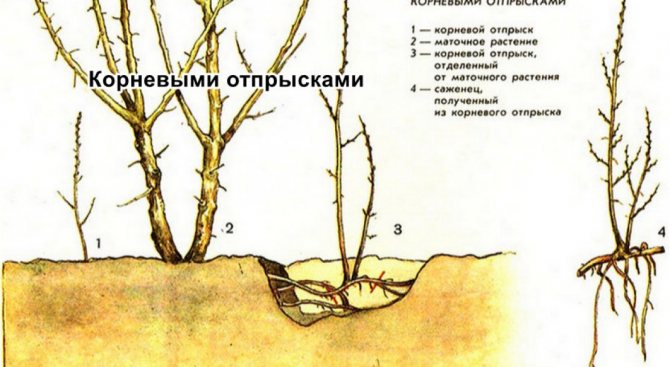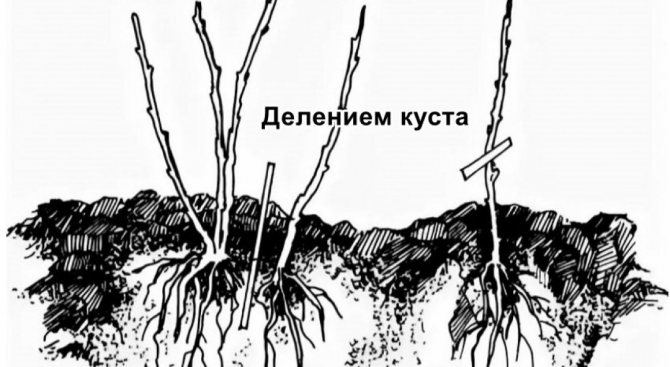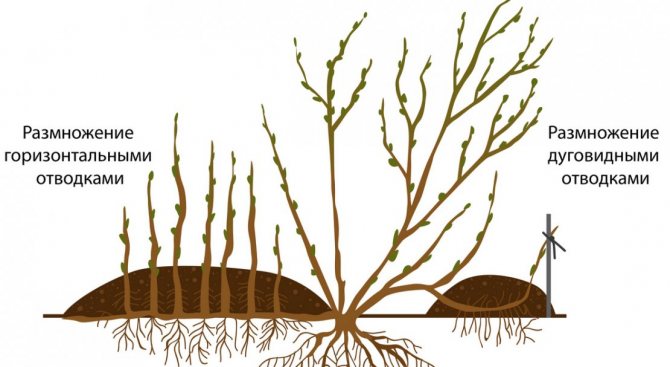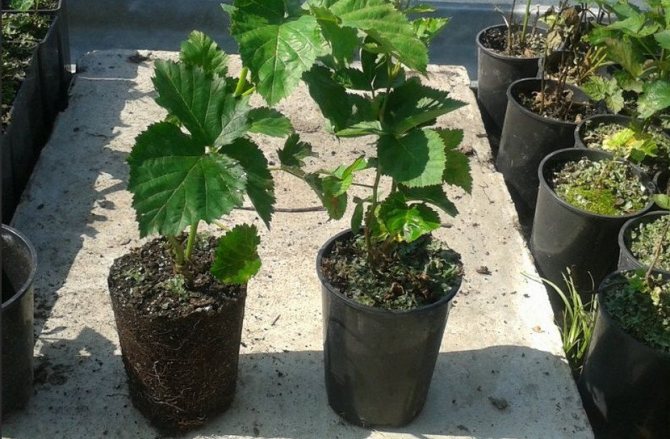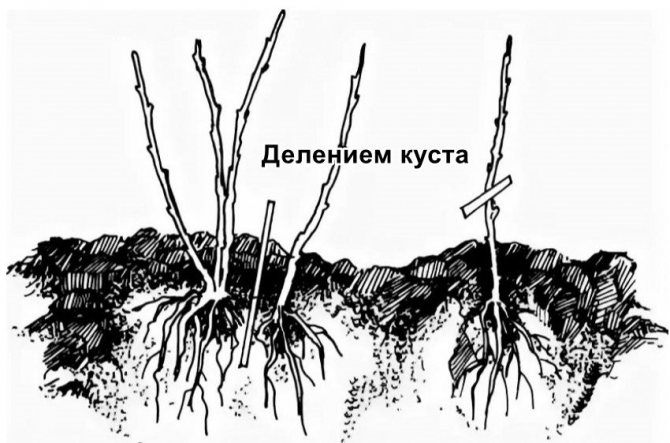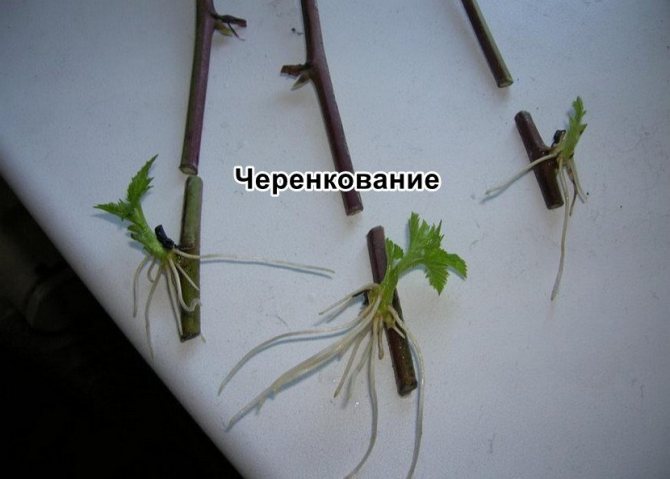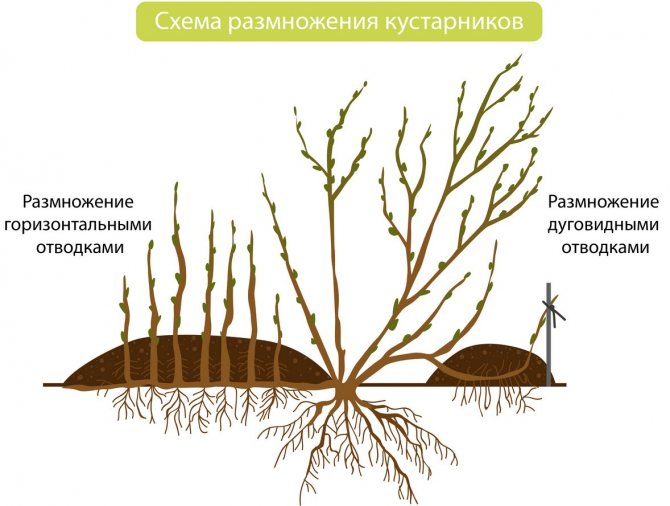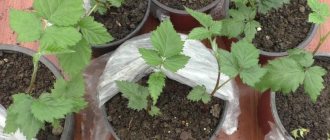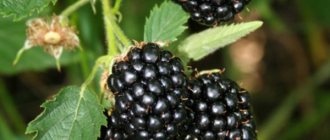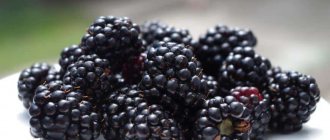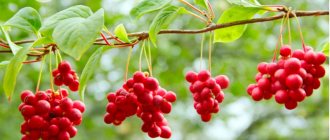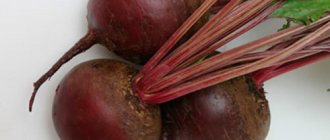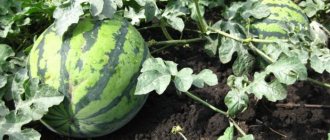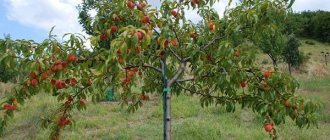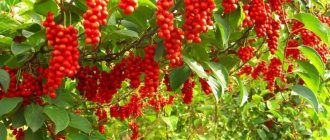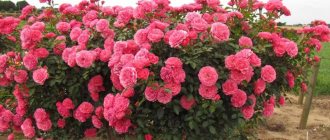How and when to plant
The development of blackberries can be successful only in those areas where in winter the temperature regime does not drop to -35 degrees. But creeping varieties do not need shelter at all, even at a temperature of -20 degrees. But in practice, with the right place, even in Siberia, the berry bush will be able to calmly endure winter frosts without creating additional insulation.
But in winter, with an insignificant thickness of the snow carpet, there is a possibility of freezing. If necessary, winter-hardy varieties can be planted in a permanent place in early spring.
For planting and caring for blackberries, it is worth choosing a site with black soil or loam with a thick layer of humus. But if you take proper care of the berry crop, then it will bear fruit even on poor land. But heavy and too acidic soils are considered unsuitable for cultivation. Blackberries do not like the proximity of underground waters.
The shrub planting process is carried out as follows:
- Run planting holes. Their depth should be 0.5 m. Prepare them for 2 weeks before planting. Add humus or compost to the soil, and also wood ash.
- If the plant is planted on dense soil, then it is necessary to deepen the bark neck by 15-20 cm. If the bush is planted deeper, then its development will slow down. For lighter soil, deepen the plant by 30-40 mm.
- After planting, the plant must be watered thoroughly. At least half of the bucket should go to one bush. It is imperative to mulch the trunk circles, and cut the shoots to 4-5 cm.
- Plant seedlings at a distance. It will vary according to the type of blackberry. Between the creeping varieties, it is 2 m, but in upright bushes, the plant is 1 m.There should be a space of 2 m between the rows.
Pre-planting works
In order for the planting of blackberry bushes to be successful, it is necessary to carry out some preliminary work.
Did you know? The shrub got its Russian name because of its thorns. Blackberries - that is, prickly like a hedgehog.
Site preparation
The first step is to clear the selected area from debris, weeds and various rhizomes. Then carefully dig up the soil, deep on the bayonet of the shovel. Before that, a mixture of organic and mineral substances is necessarily introduced into the soil in the following composition: mix 10 kilograms of humus with 20 grams of potassium sulfate, 200 grams of ash and 15 grams of superphosphate.
If in the soil high acidity, lime is still added to it. All this is evenly distributed over the surface of the site before digging. All these actions must be done a month before planting the culture.
Learn more about soil acidity: the importance of soil acidity for plants, self-determination of soil acidity, soil deoxidation.
If the soil on your site with a high level of moisture, then you need to plant it in the beds, and if it is dry, the bushes are planted in ruts, without completely covering them with earth.
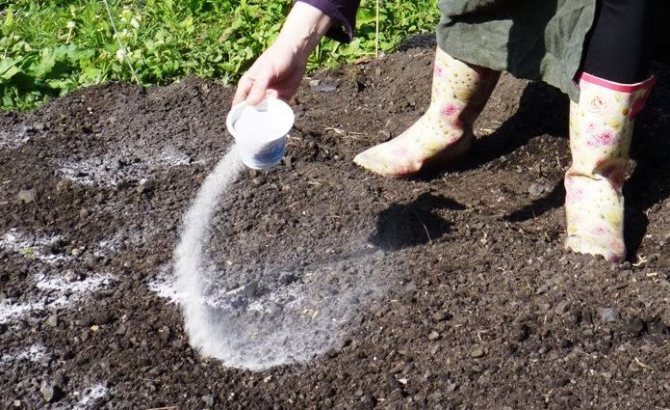
Preparation of seedlings
Before you start planting shrubs, the cuttings must be carefully examined.It is very important that the root system of the planting material is sufficiently moist, has the brown color characteristic of healthy cuttings, and the presence of mold is also unacceptable. If the planting material does not have to be planted immediately after receiving it, it should be stored with moist roots in a cool room, not in direct sunlight. Before direct planting, it is recommended to soak the roots for several hours in water or a rooting stimulator.
If you have to transport seedlings, they can be wrapped with a damp cloth or wet sawdust, and then with a film. So the roots will not dry out for a long time.
Climatic characteristics of the region
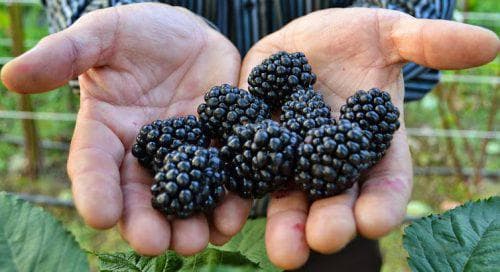

It is possible to highlight the characteristic features of the climate for each region, which must be taken into account when growing blackberries. But within the same climatic conditions, there are differences in location (for example, the site is on a mountain, near a river or in a lowland). Other factors, such as shading, the location of buildings, prevailing winds, etc., also affect the development of plants.
In Belarus, there are two wild types of blackberries - gray (ozhina) and kumanika - as well as many cultivated varieties. The flowering period here stretches from the end of June to the second half of July, and the ripening of the berries does not begin until August. In order for blackberries of earlier varieties to ripen, it takes at least a month and a half, for later varieties - over two months. Plants bear fruit best on the south or southwest side of the plot, which is illuminated by the sun for most of the day.
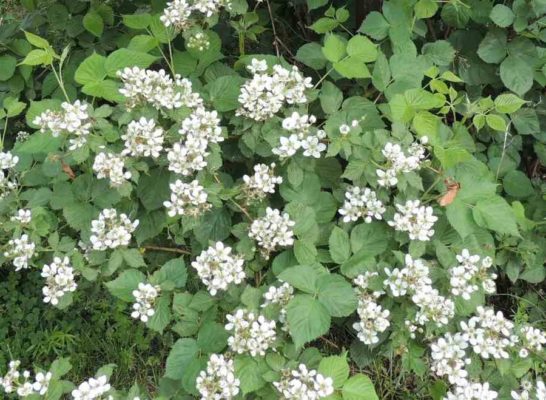

Garden blackberries bloom profusely and for a long time - almost until the end of July
The greatest harm to blackberries from this region is caused by a blackberry mite, and the most common disease is overgrowth of bushes.
The Urals are characterized by a harsh climate. The region experiences severe winters with severe frosts. It is also characterized by recurrent spring frosts, cold winds and a small number of sunny days. To harvest a crop from a blackberry, you need to choose a variety that will have time to ripen before frost.
How to care
Within six months from the moment the bush was planted, shoots formed on it. They are strong enough to produce rich crops. This happens closer to autumn. Throughout the spring and summer, it is necessary to provide the bushes with proper care.
If the bushes are two years old and have already borne fruit, then they need to be trimmed regularly. In the fall, create a shelter for the berry plant so that it does not freeze in winter. Every year throughout the spring, the blackberries need to be fed. For this, urea is used. For 1 m2 there is 25 g. Once every 3 years, the bushes are fertilized with humus. 10 kg of fertilizer is applied to each bush. It will also be useful to learn about the cultivation and care of blackberries in the Urals.
For full growth, you will have to carry out regular watering. At the same time, it should be moderate, since stagnant water will lead to the death of plants. But the soil should not dry out either, since the bush will not bloom and bear fruit from this.
For several years, water the plant using the fan-shaped method. But to raise and tie the growing loops. And young shoots that have just begun to grow should be directed to the center of the bush. In the fall, blackberries do not bear fruit, so it is necessary to prepare the bushes for wintering. Old shoots must be cut off completely.
As soon as spring has come, free the bushes from the protective coating. This manipulation must be performed before the kidneys are formed. After that, you can give the bush a shape and raise the growing shoots. Perform similar activities until the bushes begin to bear fruit.
Reproduction methods
Blackberries propagate throughout the growing season using cuttings, cuttings, root suckers or by dividing the bush.
| Way | Reproduction |
| Layers | In the spring, choose and bend the shoot or its top to the ground. In the first case, the roots will appear along the entire length of the shoot, which can be divided into several bushes, in the second, 1 new plant will be obtained |
| Cuttings | In June or July, cut the cuttings, consisting of parts of the stem, leaf and bud. Treat the cut with "Kornevin", place the cutting in a peat-sand mixture and cover with a film. After a month, the stalk will give roots and it can be planted in the ground. |
| Root offspring | In May or June, separate from the bush and plant in a new place root suckers that have grown by 10 cm |
| Dividing the bush | Separate shoots with young roots from old, dug bushes so that each delenka has developed shoots and roots |
Variety selection criteria
For a region with harsh climates, varieties that can withstand severe temperature drops are suitable. In this case, the fruits should have time to ripen before the arrival of cold weather. The ability of the bushes to withstand strong winds is also important.
For the Urals, erect blackberry varieties, which are resistant to temperature fluctuations, will be the best option. These include plant species such as Valdo and Kiova. Black Satin is also suitable.
Preparing for landing
Blackberries, which are to grow in Siberia, with its harsh living conditions, must receive proper care from the farmer, moreover, it must be planted in the right place. The selected site must meet the following requirements:
- lack of heavily shaded areas;
- enough sunlight;
- the soil of the selected area should not be excessively moistened or even waterlogged;
- sandy soil should not prevail.
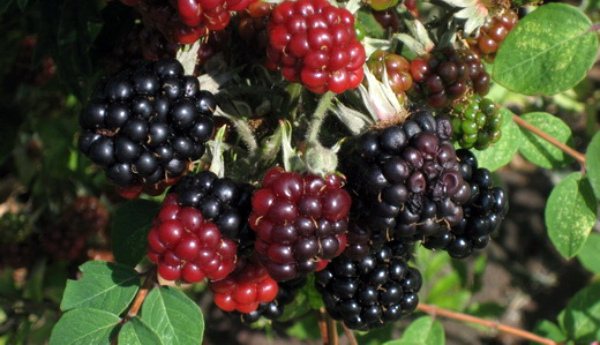

As already mentioned, in the northern regions, it is preferable to plant all varieties of blackberries in the spring. Before planting is carried out, the site should be carefully prepared: exterminate perennial weeds, remove all rhizomes from the soil, dig up the soil with high quality (adhering to the bayonet depth of an ordinary shovel).
Mineral fertilizers mixed with organic fertilizers must be applied to the land on the site where the cultivation of blackberries is planned: at least 10 kg of humus, 20 g of potassium sulfate, 15 g of superphosphate are needed per 1 square meter of the planting area.
Testimonials
- Alina, 32 years old: “Since our climate is rather harsh, it is very problematic to grow any plant. At the dacha I decided to plant fruit trees and berry bushes. I really like blackberries. I chose the Thornfrey variety for planting. Before planting, I applied fertilizer, since the soil in our country house is not rich in nutrients. After planting, I actively watered the bush, applied the necessary fertilizers and the next year I was able to harvest. From one bush it turned out 3 kg. The berries are tasty, juicy and medium in size. "
- Andrey, 25 years old: “I planted a blackberry bush in my country house. Since I live in Siberia, I chose a frost-resistant variety. But I want to note right away that I still had to shelter him for the winter, since I was warned that even frost-resistant varieties do not always tolerate such harsh conditions. I used fir trees for cover. I managed to harvest a normal crop. From one bush 4 kg. I have 5 bushes in total and they all bear fruit well. "
- Maria, 39 years old: “I planted some blackberry bushes for my children. They are very fond of berries. I chose the Agavam variety for planting. I liked that it is not particularly whimsical to care for, since you can grow it even on non-fertile soil. It was easy for me to look after. I watered it 2 times a week, loosened the soil and applied top dressing. Bushes grow quickly, and the yield is high. I managed to get 4.5 kg of berries from one bush. They are big and juicy, and the kids also like them so much. "
With proper care and proper planting, blackberries will wash off to give a rich harvest even in the climate of Siberia.Only for this it is necessary to choose frost-resistant varieties that are able to withstand winter frosts. Observing agricultural techniques, you can enjoy delicious berries that are so useful for the human body.
Modern blackberry varieties are distinguished by high yields and excellent fruit taste. In order not to be disappointed in your choice, pay attention to varieties with characteristics suitable for your climate. Blackberries require constant care, but with strict adherence to agricultural technology, they bear fruit well and are almost not affected by diseases.
Correct pruning of blackberries
After you have harvested the blackberry, be sure to prune the shoots. This is done for the following reasons:
- blackberry branches grow, as we have already said, up to several meters, and if the bushes are not formed, it will look very strange. In addition, the whips will lie on the ground and the crop will simply start to rot. Therefore, the tied up blackberries must be cut at a height of 11.5 - 2 meters, higher it will be inconvenient to pick berries;
- in the fall, you need to leave those branches on which there were berries - blackberries bear fruit for up to two years, and those that have grown over the season - next year they will also have berries. All other lashes need to be cut off. Anything over two years old does not need to be left;
- leave about 10 shoots on each blackberry bush, otherwise it will thicken too much. Half of these shoots should be those that grew in the current year.
Do not allow your blackberry to thicken too much, in this case much less sun will fall on it, the shoots will grow worse, and the berries will become smaller and smaller every year.
Blackberries are a plant that can be easily formed into hedges. It responds well to pruning and you can form bushes at your own discretion.
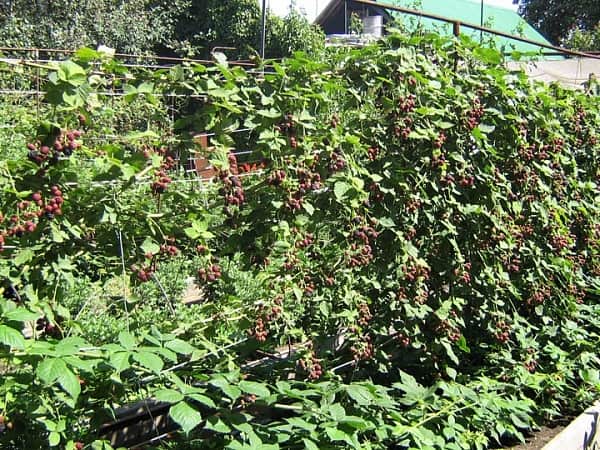

Planting, growing and caring for blackberries in the Urals and Siberia, the best varieties
In central Russia and in the Moscow region in particular, winters with little snow have begun in recent years, as well as unstable weather, when in the off-season thaws often alternate with severe frosts. Under such conditions, the blackberry should be chosen with high frost resistance of shoots and roots, since the roots on which the buds of future shoots are located cannot withstand freezing of the ground below 12-15 degrees, and thin roots that absorb food and moisture die already at 5-6 degrees of frost ... The blackberry described below is highly frost-resistant, but still sometimes requires additional shelter for the winter.
Agavam
Agavam is an old, time-tested variety of blackberries that tolerates frosts up to 30 degrees, is also drought-resistant, shade-tolerant, is not afraid of temporary flooding of the soil, is resistant to pests and diseases, the berries are rich in useful substances. The bushes are thorny, strongly spreading due to the many basal processes.
Detailed description of the Agavam variety.
Darrow
Darrow (Darrow) - tall shrub, winter-hardy, fruitful. Stems are powerful, abundantly covered with thorny thorns. Berries are sweet and sour, average weight 4 gr.
Wilsons Earley is a winter-hardy variety with early ripening of berries. The bushes are tall with drooping tops. Berries are black and purple in color, sweet and sour, oval in shape, weigh up to 2 grams.
Tornfree
Thornfree (Tornfree) - thornless shrub, belongs to the dews. Vines grow up to 5-6 m, need shelter for the winter. The berries have an exceptionally sweet taste, fully ripe, weigh 5-6 grams, and are not stored for long.
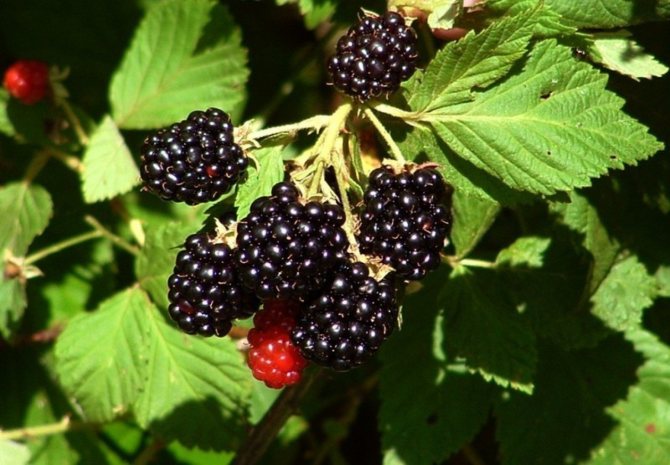

Detailed description of the Thornfrey variety.
Black Satin is a studless hybrid, for which the Thornfrey variety was the donor. Shoots can be up to 4 m long. First, they grow upward, then strongly lean to the ground, need shelter with peat or textiles. The average weight of berries is 8 grams, they have a rich sweet and sour taste, black with shine.
A detailed description of the Black Satin variety.
Apaches (Apache)
Apaches (Apache) - frost-resistant high-yielding shrub, without thorns, rarely get sick, not affected by pests. The berries begin to sing from the beginning of July, they are sweet, black, weighing up to 10 grams.
The remontant varieties described at the beginning of the article are also suitable for cultivation in the climatic conditions of central Russia and the Moscow region, provided that this blackberry is grown in a one-year cycle. In this case, later in the fall, it is necessary to completely cut off the upper part of the shrub, and carefully mulch the root system with a layer of peat or humus 10-15 cm thick.
Considering that in the Urals and Siberia there are not a very large number of sunny and warm days per year, for breeding blackberries, you need to choose frost-resistant varieties with early or medium ripening periods. However, it must be borne in mind that super-early varieties are not suitable for this climate, since spring frosts in late May or early June will be detrimental to the plant blooming at this time.
Repaired varieties of blackberries also do not take root well in the harsh climate of the Urals and Siberia. Even growing blackberries in a one-year cycle and covering the roots well for the winter will not be able to get all the potential yield. Most of the fruits do not have time to pick up sugars and ripen to cold weather. Still, for the Urals and Siberia there are some straight-growing varieties of blackberries, as well as some frost-resistant creeping varieties - mildews - are suitable for the climate of these regions, they are placed in shallow ditches in autumn to protect them from frost and covered with humus, peat or plain earth.
Eldorado (Eldorado) - blackberry of increased winter hardiness, bushes upright, strong, with large thorns. The berries ripen in August, taste very sweet with a refreshing sourness, weigh up to 3-4 grams. Eldorado is picky about the soil - it grows well only on fertile soil, shade-resistant.
Erie
Erie is a winter-hardy and drought-resistant variety of blackberries, unpretentious to the soil, tolerating partial shade well, rarely getting sick. The bush is sprawling, the root system grows to a depth of 80-90 cm. The berries are sweet and sour, with a raspberry flavor, weigh up to 3.5 grams, ripen from mid-June to mid-August.
Snyder
Snyder is a blackberry that reproduces well, prefers fertile soil, does not tolerate drought well. The berries are large, tasty, but not transportable. Bushes are upright, covered with multiple thorns.
Oregon (Oregon Thornless) - creeping shrub without thorns, winter hardy. Berries are black, weighing 5-6 grams, sweet and sour taste with a predominance of sweet, ripen from early August to early September. The yield of one bush is 10 kg.
Darrow
Darrow (Darrow) - winter-hardy hybrid with upright three-meter shoots. Berries are black with shine, weighing 3.5-4 grams, sweet and sour, overripe, become insipid. The fruiting period is extended, the yield increases gradually from year to year.
Karaka Black is a shrub with creeping shoots, withstands frosts up to 15-18 degrees, at possible lower temperatures it needs shelter for the winter. The yield is high due to the large number of fruit branches, up to 14 kg are harvested from one bush. berries. The fruiting period lasts 1.5-2 months, the harvest is harvested in several stages.
Detailed description of the Karaka Black variety.
Flint is an American variety that is resistant not only to frost up to 40 degrees, but also to most diseases and pests. Bushes are straight, powerful. The berries are very tasty, weigh up to 5-6 grams, average yield up to 10 kg. from the bush.
Ufa Local
Ufa Local is a relative of the blackberry Agavam, but its berries are much tastier and more fragrant. The weight of the fruits is about 3 grams, they are well suited for freezing. The hybrid is characterized by high frost resistance, resistance to pests and diseases.
Ruczai
Rushai (Ruczai) - Polish selection of blackberries, late ripening, bred since 2009. The variety does not produce overgrowth, winter-hardy. Bushes are powerful, tall, without thorns. The berries are large, sweet, black in color with shine. Productivity is high, transportability is at the level of industrial varieties.
To better understand which variety is right for you, you should dwell in more detail on the features of the climate of Siberia. The area under consideration is located to the east of the Urals and extends to the Pacific Ocean itself. This region is one of the coldest on Earth: its climate is continental and sharply continental.
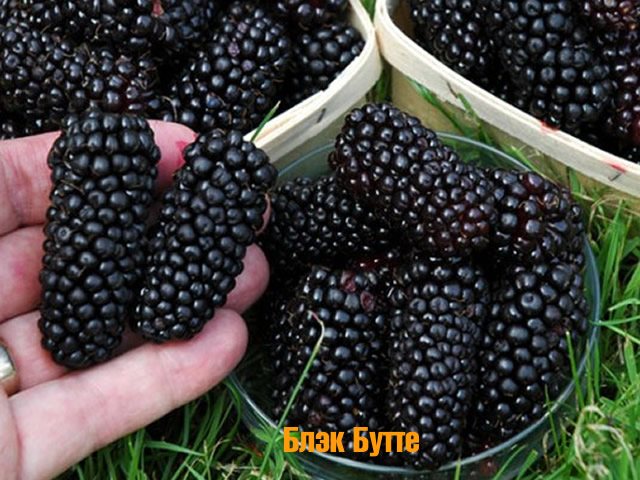

It is due to the remoteness from the seas, as well as the fact that the territory is closed on all sides by mountain ranges that do not allow warm air currents. Siberia is characterized by sharp temperature drops. The winter is long and frosty, the summer is very hot, dry, the transitional seasons (spring and autumn) are short and not very pronounced.
Did you know? Blackberries have the same effect on the human brain as caffeine. So if your performance has dropped, eat 200 g of blackberries.
Considering all of the above, when choosing a suitable variety of blackberries, you need to pay attention to the timing of fruiting, resistance to diseases, pests and adverse weather conditions, as well as the size of the bushes (especially if the site is very small).
Early
Crops of this type ripen in June when grown in the southern regions, in July - in the northern regions. The berries are not all ripe together, but gradually turn black. The yield of the crop is stretched, as a rule, for 6 weeks. A common disadvantage of these varieties is low frost resistance.
For growing in Siberia, these varieties are suitable:
- El Dorado;
- Giant;
- Black Beauty;
- Agave.
Taking into account the climatic features of the region and the main characteristics of different varieties of blackberries, the following are suitable for cultivation in Siberia:
- Black Satin;
- Boysenberry;
- Bristol;
- Thornless Evergreen;
- Thornfree;
- Darrow;
- Snyder;
- Taylor;
- Loughton;
- Eri;
- Oregon;
- Karaka Black;
- Flint;
- Ufa Local;
- Crush;
- Gazda.
All these varieties are distinguished by increased adaptive abilities and give a good harvest of tasty berries.
Did you know? For a long time, the blackberry fruit has been used as a textile dye.
Black Satin
A vigorous culture, reaching a height of 5–7 m. Up to 1.5 m, the shoots stand upright, and having overcome this mark, they begin to droop and grow horizontally, like creeping species. Bushes do not give root shoots.
The fruits ripen in late July - early August. Fruiting can last all September. For the season, the yield from 1 bush can be 20 kg, with proper agricultural technology.
The berries are not very large, 4 g each, round in shape, have a pleasant taste and a characteristic blackberry aroma. Varietal unit is resistant to diseases and pests. It tolerates a drop in temperature to -15 ° С well, therefore it requires a mandatory shelter for the winter.
Boysenberry
Refers to raspberry-blackberry hybrids. The greatest advantage of the variety is its exquisite, bright taste. The berries are very sweet, with a raspberry aftertaste and delicate aroma. The fruits are large, weighing 12 g each. Productivity per bush is 6-10 kg.
Creeping bushes. The vine reaches a length of 3-4 m, is not studded, does not require pinching. The shoots are easily attached to the trellis and are just as easy to remove.
Vegetation gives a large amount of root growth, therefore, when leaving, more attention should be paid to sanitary pruning. Winter hardiness is at an average level. Throughout Russia, Ukraine and Belarus, plants tolerate winter well under cover.
Bristol
High-yielding varietal unit. Bristol belongs to the standard forms of the average ripening period. The berries are black, dense, and can be transported well. They have a dessert taste and a pronounced blackberry aroma.
The variety has good winter hardiness, increased drought tolerance and disease / pest resistance. No shelter required for the winter.
Thornless Evergreen
The varietal unit refers to creeping forms with thornless shoots up to 6 m long. Fruit buds are tied more on the shoots than leaf buds - this is one of the features of the Thornless Evergreen variety. Vegetation does not form root shoots.
Important! If, when the root is damaged, do not immediately begin to remove the basal thorny growth, then the thornlessness of the plant will be lost.
Blackberries are successfully cultivated in Altai gardens
“Everyone who grows garden blackberries is very happy with them,” says Stanislav Khabarov, an academician of the Russian Agricultural Academy, a leading specialist in the development of technologies for the reproduction and cultivation of garden crops in Siberia. - If the berry grows on the site, you will provide yourself with vitamins and minerals, which it is rich in, from mid-summer to late autumn. Blackberries can be eaten for pleasure, there will be no harm. Like raspberries, they are natural aspirin. The substances contained in these berries improve memory, are useful for the human hematopoietic system. And all mothers need to know that blackberries do not cause allergies in children.
Simple and beautiful
Canada is considered the birthplace of cultural blackberries. It was there that a thornless culture was first obtained from wild berries.
Elizaveta Panteleeva, Chief Researcher, Research Institute of Horticulture in Siberia:
Sometimes you can hear that for gardeners there is not much difference, with or without thorns. But in practice, before planting a seedling in a permanent place, you have to hold it in your hands seventeen times.
Vigorous, thornless bushes reach a height of 3–3.5 meters. It is good to grow blackberries on trellises - such a technique Elizaveta Panteleeva noticed when she was in Hungary. Branches are tied up in the same way as a vine. The trellises are entwined with shoots, and then a solid wall of purple berries grows. If the gardens have gazebos, resting corners, then blackberries will be a wonderful decoration for them.
The biology of the blackberry is the same as that of the raspberry. One year the shoot grows, in the second year the stem bears fruit and dies off. The bushes are planted every 2.5–3 meters. Strong shoots grow over the summer. For the bush to grow, you need a lot of space. The holes are dug so that the roots are well placed.
- Blackberries are not frost-hardy enough, - says Elizaveta Ivanovna, - therefore, from autumn, annual growths are covered. Potato tops, which are always at hand in the garden, are good for keeping snow. Biologically active substances and the absence of thorns attract rodents to the blackberry, so you need to take protective measures against mice. In my garden I have been using pieces of old felt boots soaked in tar for a long time. I spread them out under bushes and apple trees, and the mice walk around my garden.
If the blackberry is planted in separate bushes, then the arrival of spring can be accelerated for it. To do this, you need to put pegs around the perimeter of the bush and pull a plastic wrap over them in the form of a sleeve. Do not tie the top so that there is no burning. With the onset of warmth, the blackberry will enter the growing season earlier. Otherwise, due to the long flowering, the last berries will not have time to ripen, and we will not get such a harvest as in Hungary or Canada.
reference
Ivan Michurin was the first in Russia who began to study blackberries at the beginning of the last century. The original forms were taken from Canada. Unfortunately, at that time, large-fruited blackberries did not become widespread. Perhaps there were not enough planting materials, or perhaps simply because there are enough wild blackberries in Russia. About 300 varieties of this berry are now known. The varieties of Young, Lagana, Thornfree have reached our places.
Blackberries multiply easily. The grown shoot must be pinched, then two shoots will grow from the top instead of one. Bend them to the ground, pin them. They will root well over the summer, and by the end of the season you will have your own seedlings.
Blackberry seedlings with a closed root system are sold at the Institute of Horticulture of Siberia named after M.A. Lisavenko. Until May, they can be held in cups on the windowsill, and then planted in the garden. Photo from the archive of the editorial office.
Planting, growing and caring for blackberries in the Urals and Siberia, the best varieties
After the berries ripen, the stems dry out at the age of 2 years. The bush leaves are dried, brewed and drunk like tea. Ripe fruits of the plant are rich in organic acids, vitamins, pectin.
Observing the requirements for planting and caring for blackberries in the Urals, you can count on a good harvest.
After the cultivation of a wild perennial, in addition to the creeping plant variety, an erect blackberry was bred.
But almost all varieties of dwarf shrubs do not withstand such frosts as raspberries, which belongs to the same genus Rubus.
In Siberia, where the air temperature drops to -40 ° C, blackberries grow, but it is necessary to plant varieties that are adapted to the harsh climate conditions and take into account that you still have to cover the bushes.
For the Urals, where strong winds blow, preference should be given to erect frost-resistant shrubs.
The culture of the genus Rubus in North America is grown on an industrial scale. In Russia, it is planted mainly by summer residents in the Leningrad region, and in the Moscow region, and in the Far East, and in the Crimea.
Blackberries take root and bear fruit in Siberia:
- Taylor;
- Agave;
- Loughton;
- Thornfree.
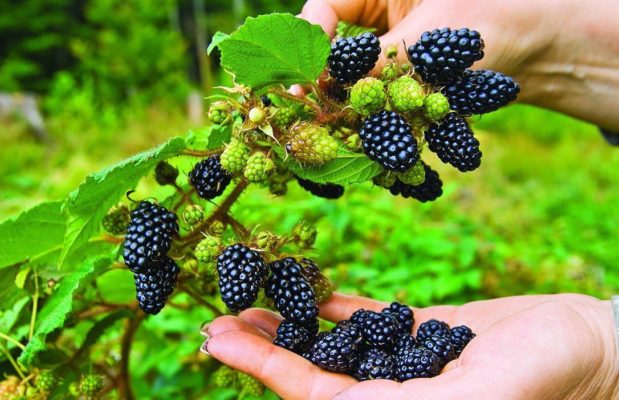

The varieties are valued for their large berries and decorative appearance. All of them can withstand frost, but in a harsh climate they take refuge for the winter.
Early
In Siberia, it is recommended to plant blackberries, which ripen not in September, when it is already cold, but at the beginning of summer. The Eldorado variety takes root in regions with a harsh climate. Erect bushes have long shoots covered with large thorns. In early June, the Giant blackberry ripens. The fruit weighs only 7 g, but the plant gives a good harvest, is valued for its high winter hardiness.
One of the new early Black Bute hybrids is distinguished by large fruits, individual specimens weighing 20-23 grams. Oval blackberries Agave are harvested in several stages. The bushes of this variety are of medium height, thick shoots falling down, dotted with brown thorns. The plant can withstand frosts down to -30 ° C.
In a temperate climate, the Tupi blackberry variety takes root. An upright bush with small thorns is rarely affected by diseases, it tolerates frosts under cover. The harvest ripens by the beginning of August. The weight of one berry reaches 9-10 grams. The Loughton variety is distinguished by amicable ripening; in a favorable year, a whole bucket of small blackberries is harvested from the bush.
A plant with long branches does not suffer from diseases, but frosts at -20 ° C are only tolerated under cover.
Late ripening
In regions where the summer is short, varieties with early ripening are planted, but in southern Siberia, Texas blackberries bred by Michurin are grown. On the creeping bushes in August, fragrant, sour berries, weighing about 10 grams, ripen, which can be preserved and frozen.
Blackberries must be covered for the winter. Harvested in the last month of summer and September. On one branch of the plant, 15-17 small fruits are tied.
Shade tolerant
Blackberries take root in different conditions, but the taste of the berries deteriorates with a lack of light, with damp and rainy weather. The shrub adores the sun, but some varieties feel fine in the shade. These include Agavam, their virtues are called:
- exceptional frost resistance;
- high productivity;
- good berry taste.
Thornless Evergreen variety grows in the shade. There are no thorns on the shoots of the plant. More than 60 small fruits are tied on one hand.
Frost resistant
Darrow's blackberry adapts well to the cold winters of Siberia. An upright bush covered with thorns does not die at a temperature of -35 ° C.
Possess high frost resistance:
- El Dorado;
- Agave;
- Snyder.
American hybrid Thornfrey pleases with large berries. A powerful plant with long shoots does not suffer from diseases, tolerates cold winters normally, but under cover.
Repaired
To increase the yield of blackberries, the bushes are thinned out, leaving no more than 5 branches. In Siberia, where cold autumn quickly comes, among the remontant varieties of plants strewn with fruits, only a few take root - Black Magic and Ruben with large berries and good winter hardiness, as well as Prime Yang, adapted to adverse conditions.
In regions where there are few sunny days with high temperatures, blackberries are planted, which can withstand severe frosts, and have time to ripen before the cold weather. In the Urals, erect varieties of semi-shrubs that are less affected by the wind take root better - Black Satin, Kiova, Valdo.
Early
In a harsh climate, the Eldorado blackberry feels fine, which is not only distinguished by its high winter hardiness, but also pleases with berries of a pleasant taste that ripen at the beginning of summer. The Snyder variety is not affected by fungi; it grows on any soil.
Shoots of an erect bush covered with large thorns do not freeze at low temperatures, small fruits ripen by the end of June. Polar tolerates spring drops, withstands frosts at -30 C, sweet blackberries are harvested in the first month of summer.
One plant produces up to half a bucket of berries.
Mid-season
The fruits of the Gazda variety, created in Poland, manage to ripen in the Urals. The tall bushes of the hybrid tolerate severe cold, do not suffer from diseases. On shoots, poorly covered with thorns, blackberries ripen in early or mid-August, harvesting ends in September.
Loughton pleases with a high yield, the berries ripen by the end of summer.
Late
In the Urals, mainly blackberry hybrids are planted, the fruits of which ripen in July. Texas and Oregon Thornless endure low temperatures under cover. Both varieties delight with a large number of berries. A bucket of fruits are collected from one bush, which ripen by the end of August - beginning of September.
Winter hardy
Agavam endures the lowest temperatures. Almost does not lag behind this variety Gigant. Erect Darrow bushes do not freeze at -35 C. The winter-hardy hybrids Thornfrey and Amara can withstand the Ural frosts.
Bush
Blackberries with erect shoots tolerate low temperatures and strong winds, but require shelter in northern latitudes. The stems of these plants are covered with thorns or thorns, reaching a height of 2 meters. In the Urals, bush varieties Ruben, Agavam, Gazda take root.
Creeping
In the forests of Europe, the Asian taiga, in the wild, you can find a dewdrop, the shoots of which spread along the ground, reaching 4–5 meters. Such blackberries bear fruit in the shade, they are not afraid of drought. In the Urals, hybrids are cultivated in Oregon Thornless, Texas, but in winter they freeze out without shelter.
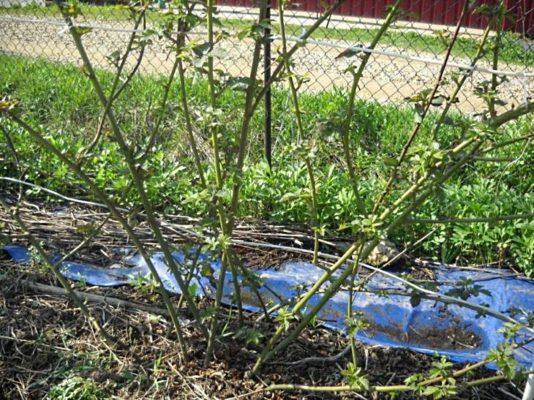

It is not so easy to leave a blackberry in a harsh climate, but subject to the requirements of agricultural technology, careful care, it rewards berries, rich in useful components.
In Europe and America, where blackberries are cultivated on an industrial scale, there is not much difference when to send plant shoots to the ground - in spring or autumn, but it depends on this period whether the shrub will survive in a climate with cold winters and late frosts. To eliminate the risk of death of blackberries in the Urals and Siberia, they are planted in the first decade of May or from September 1 to 15. In this case, the highest probability is that the plant will not only survive, but will also be able to take root.
The place for blackberries should be well lit by the sun, be inaccessible to northern winds. The semi-shrub feels comfortable at a distance of a meter along the hedge or fence from the west or south side. Blackberries need fertile soil, not rocks, salt marshes or swamps. The culture dies when the roots reach the groundwater.
Having chosen a suitable place for the plant, the entire area is freed from weeds, the remains of the stems are removed, the soil is carefully dug up.
Site preparation
Since blackberries are demanding on soil fertility, before planting, the land must be fertilized with organic matter and mineral complexes.
For 1 sq. m of area is contributed by:
- humus bucket;
- 2 tbsp. tablespoons of potassium sulfate;
- 100 g superphosphate.
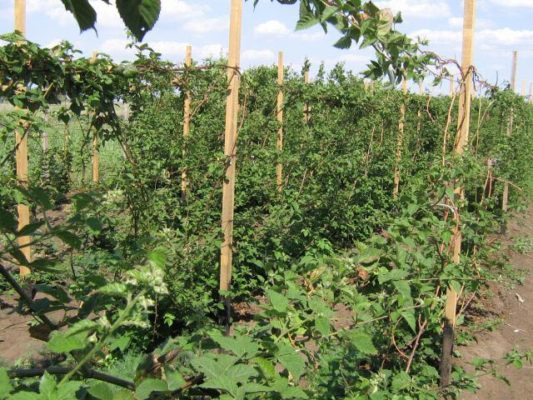

10-15 days before planting blackberries, deep holes with a diameter of 40-50 cm are dug in several rows on the site, leaving a distance of 1.5 m between each.
The bushes of the culture, which are preferable to buy in the nursery, are soaked in water, where they must stay for at least half a day.
The seedling is placed in the hole vertically, deepening the neck by 2 or 3 cm, the roots are laid on a mound made in the hole. After that, a groove is dug around the bush, half a bucket of water is poured, the ground near the plant is mulched with peat. The shoots are pruned, leaving branches up to 5 cm long.
Follow-up care
If you take care of the blackberry, even in a harsh climate, it rewards the first fruits. In order for the roots to be saturated with oxygen, you need to constantly loosen the soil throughout the entire area.
Irrigation
The first month or 2 after planting, the bushes need to be watered frequently. After the blackberries are rooted, the amount of moisture is reduced. But when the berries begin to ripen, 2 buckets of water are poured under each bush once a week.
In the spring, blackberries need nitrogen, it is found in urea. Every 2 years, a bucket of compost or humus is applied under the bushes, and the stems and leaves are sprayed with Bordeaux liquid.
Garter on supports
The shoots are attached to the wire in the center, and the fruiting shoots are directed sideways, weaved together in twos, or allowed to drag down. Tying to a support in any of these ways makes pruning easier, simplifies picking berries.
Formation
If the shrub produces flowers in the first year, it is advisable to cut them off. The next spring, the branches are shortened by 15 centimeters. In the summer, fruiting shoots are cut off completely, and excess growth is removed.
Even cold-resistant hybrid varieties of crops in Siberia and the Urals often freeze out. To prevent this from happening, in the fall they dig a trench where young branches are laid, covered with needles, sawdust. In the spring, before the buds appear, the plant is freed from the covering material.
In order to grow a crop and reap a good harvest from it, it is necessary to provide it with quality care.
Optimal timing
Planting work is recommended in early spring. This helps to avoid freezing of young crops.
Blackberries need lots of sunshine. It is important to ensure that it is not exposed to wind and drafts. It is recommended to plant bushes near the fence. This will provide them with the support they need.
In the springtime, blackberries are planted in the spring, before the buds appear. To achieve good results, it is worth using a fertile and drained soil. Loam or sandy soils are great options.
- 1 Varieties for Siberia
- 2 How and when to plant
- 3 How to care
- 4 Reviews
Varieties for Siberia
Blackberry pests and diseases
Most often, the culture is affected by fungal diseases. The main signs of fungal infections are spots on the leaves and stems.
Septoria (White Spot) - The most common cause is infected seedlings. The disease manifests itself in the rainy season, appears on last year's shoots. Light brown spots appear on the leaves, gradually turning white. The plant stops growing, the berries become smaller, do not ripen and rot.
Affected shoots, leaves are cut and destroyed.
To prevent the disease in the spring, before bud break, the bushes are sprayed with a 1% solution of Bordeaux liquid, Fitosporin M (5 drops per 1 liter of water).
At the first manifestations of the disease, the bushes are sprayed with Gamair's solution (1 tablet per 1 liter of water).
Anthracnose - a fungal disease, in which the leaves along the edges and along the veins become covered with gray-violet spots, the twigs dry out and die off, the fruits disappear.
To combat the disease, fungicides are used: Oxyhom, copper oxychloride, Previkur, Fundazol.Treatments are carried out 3 times after 2 weeks.
Often the culture is affected by rust. Small velvety yellow dots appear on the leaves and stems, gradually turning into large spots. With significant lesions, the leaves fly around, the shoots wither.
Preparations help to fight rust: Fitosporin, Topaz, Bactofit, Bordeaux liquid solution (1%). During treatment, 2 treatments are required with an interval of 7-10 days.
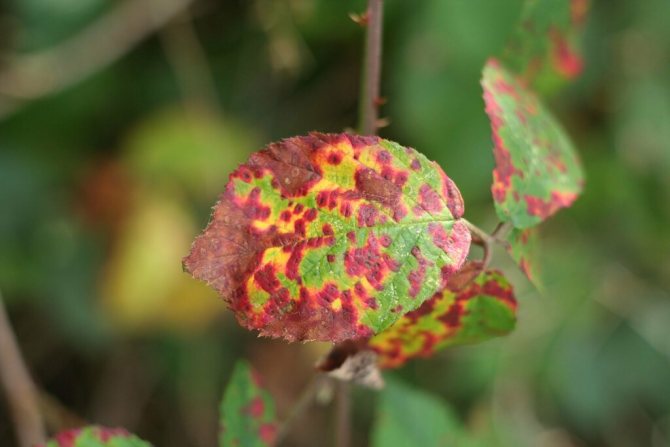

Cultural pests:
Khrushch western may damages plant roots by gnawing them. During the flowering period, the pest feeds on leaves.
To protect against crumbling, the roots of the seedlings are soaked for 30-40 minutes in Aktara's solution before planting.
In case of a beetle invasion, the soil is treated with the preparations Antichrushch, Confidor
Raspberry beetle - damages leaves, inflorescences, stems, roots. The beetles hibernate in the soil and come out in the spring. They gnaw holes in flowers, berries. Rot is formed in the affected areas.
For prevention, the soil is dusted with tobacco dust or wood ash.
7-10 days before the blooming of flowers, the bushes are sprayed with solutions of Aktellik, Iskra, Kemifos.
Spider mite - lives on the outside of the leaves, forming a cobweb. It feeds on the juice of all vegetative parts of the plant.
When infected with a tick, plants are treated with Fitoverm, Aktofit, Bi-58.
The number of treatments is 3 times after 7 days.
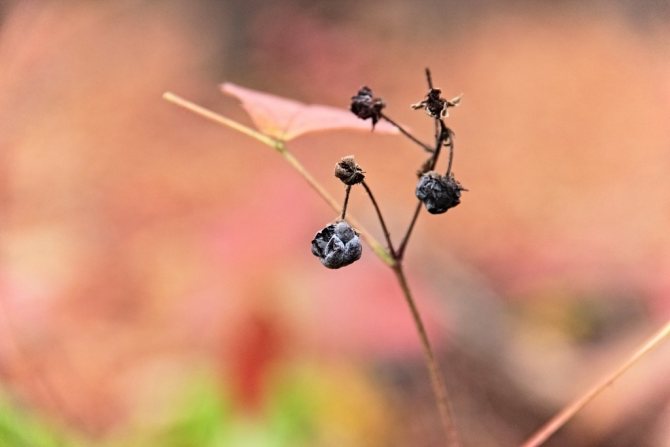

The main stages of agricultural technology
Blackberry care includes regular watering, fertilization, timely pruning of bushes, and protection from diseases and pests. Most cultivars need shelter for the winter.
Planting blackberries
Blackberry seedlings grown in containers can be transferred to a permanent location at any time. Plants with an open root system suffer more from high temperatures and lack of moisture. Therefore, it is better to plant them in autumn or early spring.
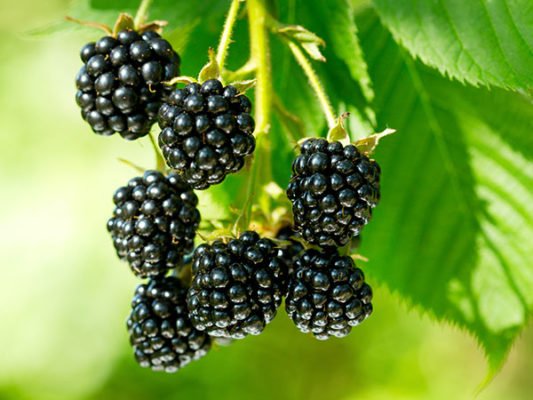

With proper cultivation, blackberries begin to bear fruit abundantly already in the second year after planting.
Further care
To get a strong and powerful plant, it is necessary to provide it with high-quality and complete care.
It is worth watering the plant systematically, but it is recommended to use a moderate amount of liquid. It is important to ensure that the soil does not dry out. At the same time, standing water also has a negative effect on the bushes.
Fertilizer
In the spring season, blackberries require the use of nitrogen fertilizers. This component is present in urea. It is also worth bringing in a bucket of humus or compost. This is done with an interval of 2 years.
Garter on supports
The blackberry vine is very long. At the same time, the berry clusters often hang down, weighing down the bush. Therefore, plants need a trellis. The most common option is a flat support. In this case, the vine is usually tied up in a fan manner.
It is best to do the trellis at arm's length. The bottom wire should be placed 1 meter from the ground. This prevents the brushes from touching the ground.
Crown formation
In the first year, the plant does not need pruning. This will ensure quality rooting of the culture. In this case, it is worth getting rid of the inflorescences and frozen ends of the shoots.
From the second year, the branches should be pruned, giving them a length of 1.5 meters. Thanks to this, it will be possible to achieve abundant flowering and increase yields. At the beginning of summer, bushes that give a large number of shoots should be thinned out. In this case, it is recommended to remove young branches, leaving the most powerful ones.
How to plant blackberry seedlings
So let's move on to disembarkation:
- Place the blackberries on a wire trellis in one or two rows. On both sides of the trellis, pits are prepared for planting 40 by 40 centimeters in size, at least 50 centimeters deep. These are the optimal sizes for high-quality development and growth of roots, which in blackberries are distinguished by their power. The pits must be located at a distance of at least 1 meter from the border with the neighbors' plot, if the rows are parallel to it.Small rows, one and a half to two meters long, can be placed perpendicular to the fence, preferably on the south side of the site. A space up to 2.5 meters wide is left in the aisles, and the shrubs themselves in a row are placed at a distance of 1 meter to 1.5. If blackberries are planted with bushes, then the planting scheme looks like this: 1.8 by 1.8 m.
- Further, humus is poured onto the bottom of each hole and mixed with the ground. Be sure to pour a layer of soil on top of this mixture so that the delicate roots of the cuttings cannot come into contact with the humus itself.
- Then the cutting should be carefully placed on the bottom of the hole, carefully sprinkle the roots with earth and compact. So you need to pour several layers, strictly making sure that the seedlings are planted to the depth of the root collar.
- Considering that blackberries are very fond of water, it is necessary to water the seedlings quite well during planting, but not excessively. Each bush uses about 5 liters of water. This must be done while adding each separate layer of soil: water and let each portion of water soak well, and then add the next layer of earth.
- At the end of the planting of seedlings, you need to cut off the aerial part from them with a secateurs, while leaving 2-3 buds on the trunk. This pruning will stimulate the growth of dormant buds on the root system. It is from these that the plant will develop young shoots.


It should be borne in mind that during watering, the soil with seedlings sags, therefore, plants should be planted at the optimal depth: not above and not below the level of the root collar. If these recommendations are not taken into account, then in the planted high seedlings, freezing of the roots is possible, and in those planted low, the growth of shoots may slow down or the plant will not develop at all and will die.
Did you know? Blackberries have long been considered a medicine, for example, in the writings of Paracelsus there is a recipe for a medicinal decoction based on its berries and leaves.



